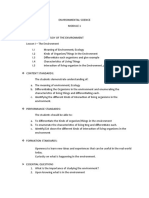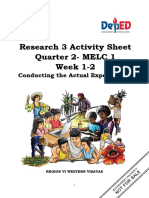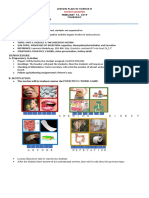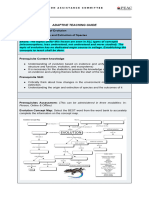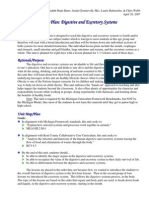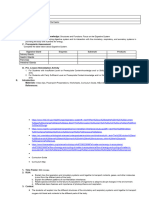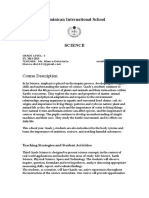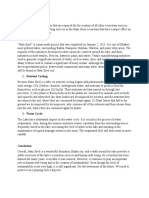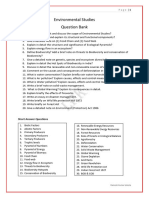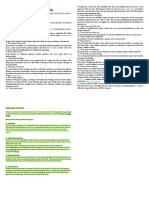Plan Sains t2
Plan Sains t2
Uploaded by
Arif ZaidiCopyright:
Available Formats
Plan Sains t2
Plan Sains t2
Uploaded by
Arif ZaidiCopyright
Available Formats
Share this document
Did you find this document useful?
Is this content inappropriate?
Copyright:
Available Formats
Plan Sains t2
Plan Sains t2
Uploaded by
Arif ZaidiCopyright:
Available Formats
THEME: MANAGEMENT AND CONTINUITY OF LIFE LEARNING AREA: 1.
0 THE WORLD THROUGH OUR SENSES Chapter 1)
Week
Learning Objectives\Learning outcomes
Suggested Learning Activities Carry out to Approach Strategy Skills
No of period s Notes
.1
1. Understanding
the sensory organs and their functions
activities make connection between five the
A student is able to: y Identify and relate a sensory organ to its stimulus, y State from the pathway to stimulus
the
senses, sensory and Constructivism Observing The five sensory organs have been introduce d Primary Science. in
organs
the stimuli.
response: 4 JAN / 8 JAN Stimulusp Sensory organsp Nervesp Brainp NervespResponse
Discuss what happens our after stimulus detected. in body a is Discussion Communicatin g
1. Understanding
sense of touch. A student is able to: y
the
Carry activities study following: a)
out to the
Identify the structure of the human skin involved detection, in stimuli
Structure Experiment discovery. and
of the human skin involved in stimuli detection, b) Sensitivity of the skin at different parts of the body towards stimuli
State the function of different receptor pressure, heat, pain, Draw conclusion on the sensitivity of the skin at different part of the body towards
Observing and experimenting
The structures of are 2 the not receptors
Discussion
required.
stimuli. 11 JAN / 15 JAN Discuss the skin the in
sensitivity of connection to the following situation: a) b) Braille Discuss 1.3 Understanding sense of smell. A student is able to: y Identify the structure of the nose y Identify the position of the sensory cells in the detection of smell the structure the cells the of receiving using an injection
the nose and position using Discussion 1 Communicatin g of the sensory model, charts, computer software and other teaching aids. Observing Identifying
Week
Learning Objectives / Learning Outcomes
Suggested Learning Activities Carry out to the Approach Strategy Skills
No of period s Notes
1.4 Understanding the sense of taste A student is able to: 3 y Identify the different areas of the tongue 18 / y 22 Jan that respond to different taste, Related the sense of taste with the sense of smell.
activities detect different
areas of the tongue respond different tastes. Constructivism Carry activities find out to how Relating that to Inquiry Discovery Identifying 2
taste related smell.
is to
Teacher 1.5 Understanding the sense of hearing. A student is able to: y 3 y Identify the structure of the human ear. Explain the function of the different parts of the ear, y Describe hear. how we Observe and identify structure the ear. Discuss function the ear. Discuss hearing mechanism. the the of the of Describing Contextual learning Explanation 2 is encourag ed to use computer simulatio n the Identifying hearing mechanis m to illustrate
human
each part of
Examine the cow's eye or model 1.6 Understanding the sense of sight. A student is able to: 4 y Identify the structure of human eye, y 25 / 29 Jan Discuss how we see. 4 1.7 Understanding light and sight. A student is able to: Carry activities study: a) Reflection of light, out to Experiment y Explain the function of different parts of the eye, Describe how we see Collect information on structure 2 and function of each part of the eye. 3 human eye. of
b) Refraction y Describe reflection refraction, y 5 y State the various ways and of to give the defects of vision, Explain State examples correct vision defects, 1 FEB / y y the and of mediums different density. Collect information about types defects the of of Contextual learning light of properties or light i.e between two
limitations of sight, Connect stereoscopic and monocular visions with the survival of animal, y Identify appropriations sight. the of
vision and the contribution/ use of technology to rectify them Carry activities show short sightedness and long sightedness are and how to them. correct out to what
5 FEB
Learning Wee k Objectives/ Learning Outcomes 5
Suggested Learning Activities Discuss what
Approach Strategy
Skills
No of periods
Notes
Binoculars, ultrasound 2 scanning device, X-ray, periscope 2 Generating idea 1 Communicati should included. be
astigmatism is and the way to correct 6 it. Carry activities 08 Feb / 12 investigate following: out to the
1. Optical
illusion,
Feb
2. Blindspot. Discuss the
ng
connection between stereoscopic 15 vision and
Feb / 19 Feb
monocular vision with the survival of animals. Gather information about the device to overcome the limitation of sight. 1.8 Understanding sound and hearing. A student is able to: Carry activities investigate: out to 2
(CUTI TAHUN BARU CINA 2010)
1. The
y 8 Describe the properties of sound, y Explain the 22 Feb / 26 Feb y reflection and absorptio n sound, Explain ways the defects in hearing, y State the limitation of hearing, Discuss the of rectifying of productio n of sound. 2. The need of medium for sound to travel. 3. The reflection and absorptio n of sound. Collect information about 2
Include Experiment Observing 3 Inferring Discussion devices and stethoscope. such
as hearing aids
1. The
defects of hearing, 2. Ways to rectify the defects of hearing.
State the device used the limitation s hearing, Explain stereopho nic hearing of to overcome
limitations of improving it. Carry activities investigate need stereophonic hearing determining direction sound.
of
hearing and ways out to the for in the of
1.9 Understanding the 9 stimuli and in responses plants. A student is able to: 01 Mac / y State the stimuli that cause response 05 Mac y in plants, Identify the part of plants sensitive to specific stimulus, y Related the response
Carry experiments investigate identify:
out to and 3
1. Stimuli
detected by plants, 2. The parts of the plants sensitive to specific stimulus. Making Inquiry Discovery Relating Experiment inference Responses in plants should include phototropism, geotropism, hydrotropism, nastic movement, trigomotropis Discuss in what ways the response of plants towards stimuli survival. are important for their m.
in plants to their survival.
PEKA Test 1
LEARNING AREA:
Learning Objectives/ Learning Outcomes 2.1 Analysing the
2. NUTRITION (Chapter 2)
Approach Strategy No of periods
Week
Suggested Learning Activities
Skills
Notes
classes of food. A student is able to: 10 y Explain through examples 08 Mac / 12 Mac y y State function food, Test for starch, glucose, protein fats. and Carry out activities to test for starch (iodine solution), protein Discussion Defining operationally TEST 1 (Million's reagent) and fats (alcohol-emulsion test). Contextual learning Making inference 3 the the of classes of food, Discuss the classes of food i.e. carbohydrate, protein, fats, vitamins, minerals, functions. Explanation 2 fibre and Experiment Brainstorming water and state their
each class of
Week 11: MID SEMESTER BREAK 14 Mac 21 Mac 2010
1. Evaluating the
importance of a balanced diet. Discuss: a) what balanced died is, A student is able to: y State what a balanced 12 y is, State factors 22 MAC / 26 Mac y must considered when planning a balanced diet, Explain the effect balanced diet, y State quantity gram carbohydrate, protein fats. and the of y of how factors a y Discuss estimate calories meal. Plan balanced for lunch dinner) a (breakfast, and a diet day. to the of Discussion the that be diet b) the factor that determine a person's balanced diet: age, size, sex, job, climate, state of health. Collect food wrappers that show calorific Inquiry Discovery Predicting Mastery learning Defining operationally 2
Brainstorming
value of food and make a list to show the calorific value for each type of food.
food taken in a
energy in each
Estimate calories meal,
the of
food taken in a
Plan a balanced diet.
Week
Learning Objectives / Learning Outcomes
Suggested Learning Activities
Approach Strategy
Skills
No of periods
Notes
2.3 Understanding the digestive system in man. 13 / 14 y Explain Identify parts 29 Mac / 09 April y system, Describe the flow of food particles in the alimentary canal, y State the function of the organs in the digestive system, y Describe process the of of what the the Identify parts of the digestive system and the flow of in food the Discussion Identifying particles A student is able to: Discuss that digestion is the breakdown of large food molecules into smaller soluble molecules that can be readily absorbed by the body. Constructivism Discussion digestion is, y
digestive
alimentary canal using model/chart/CD ROM. Discus the functions of the various organs in the digestive system Experiment Communicating
02 April
"Good Friday 2010"
and the enzymes found. Carry out activities to show the action of the enzyme in the saliva on starch.
digestion in the
alimentary canal, y List the end of of and products digestion carbohydrate, protein fats.
2.4 Understanding the process of absorption of 14 digested food. A student is able to: y Explain process absorption digestion, y Make inference about absorption glucose through Visking tube Learning Week Objectives\Learning outcomes a the of Carry out an Discussion the of of Discuss the process of absorption of the product of digestion in the small intestine. Contextual learning Explanation 2 Making inference
the products of
experiment to show the absorption of glucose through a Visking tube. Experiment
Suggested Learning Activities
Approach Strategy
Skills
No of periods
Notes
15
2.5 Understanding the reabsorption of water and defecation.
Discuss
the
Constructivism 2 Observing
reabsorption of water by the large intestine
12 April / 16 April
A student is able to: y State water reabsorbed the intestine, y Explain defecation, y Relate problem eating habits the of how is in
and
the
process
of Communicating Relating
defection.
Discuss the importance of good eating habits to avoid constipation.
Group discussion
large
defecation with
2.6 Put into practice the habits of healthy eating. A student is able to: y Justify eating nutritious food, y Put in practice good habits, y Justify generous distribution of food to the underprivilege d / needy, y Relate of people conforming to sensitivities and religious the different dining culture the eating the Plan and carry out a healthy eating habit. Discuss the following topics:
importance of
1. Practicing
good eating habit i.e. eating nutritious food and eating nutritious food and eating in moderation, 2. The generous distribution of food to the underprivilege d / needy, 3. Cultural practices in dining conforming to sensitivities and religious beliefs. Justifying
Mastery learning
Relating
Discussion
Predicting
beliefs.
THEME: MAN AND THE VARIETY OF LIVING THINGS
LEARNING AREA: 3.0 BIODIVERSITY (Chapter 3)
Week
Learning Objectives/ Learning Outcomes 3.1 variety Understanding of and living their
Suggested Learning Activities
Approach Strategy
Skills
No of periods
Notes
16
organisms classification
Discuss the diversity in the general characteristics of living organisms. Mastery learning
Basic concept on variety of living organisms in has been introduced primary science. 2 Classifying 2 Emphasize only on the the suggested classification in learning activities.
A student is able to: y Explain diversity living 19 April / 23 April y organisms in a habitat. Classify various animals based on common characteristics, y Classify various plants based common characteristics, y Explain the importance of biodiversity to the environment. on the of
Collect various based
and plants on
classify and Discussion
animals into a system common characteristics. y Animal: invertebrate, vertebrate, mammal, reptile. y Plant: flowering plant, non flowering plant, monocotyledon, dicotyledon. y Build a concept map on living organisms based fish, bird, amphibian, Generating ideas
1 Malaysia is one of the megabiodiversity countries in the world should be highlighted.
on classification above.
the
Discuss the importance of maintaining the biological diversity as one of the country's heritage. natural
PEKA Test 2
LEARNING AREA: 4.0 INTERDEPENDENCE AMONG LIVING ORGANISM AND THE ENVIRONMENT (Chapter 4)
Week
Learning Objectives/ Learning Outcomes
Suggested Learning Activities
Approach Strategy
Skills
No of periods
Notes
4.1
Analysing
the living
Carry out a field work to study species, habitat, Inquiry discovery Observing population, community in an ecosystem.
Basic concept habitat been introduced in Identifying 2 primary school. Discussion of has
interdependence among organisms. A student is able to: 17 y State species, population and community what
Carry out a discussion on interdependence among living organisms and the environment to create a balanced ecosystem.
are, y State habitat 26 April / 30 April y Identify various habitats in one ecosystem, Explain through examples the interdependen ce living organisms and the environment to create a balanced ecosystem. among what and
During field the of will through contextual learning.
the work
concept ecology be
ecosystem are, y
constructed
17
4.2
Evaluating
the
Collect and interpret data on the types of interactions between living organisms as follows:
Basic concept and competition has taught primary Explanation Generating ideas 3 school. been in of prey predator
interaction
between
living organisms. A student is able to:
1. Prey-predator, 2. Symbiosis:
y List the type of interactions between living organisms, y Explain interactions between living organisms, Conduct an activity to show the importance of the interaction between the examples the commensalisms, mutualism and parasitism e.g. remora and shark, algae and fungi, type worm and man, 3. Competition.
Constructivism
Justifying
Discussion
Predicting
Justify interaction between living
the
organism environment.
and
the
importance of
organisms and the y environment, Explain through examples the advantages and disadvantages of biological control in regulating the number of pest in certain areas.
Discuss the advantage of biological control in regulating the numbers of pests in certain areas.
Refer to local issues like the crow problem in Kelang.
Learning Week Objectives\Learning outcomes
Suggested Learning Activities
Approach Strategy
Skills
No of periods
Notes
4.3 Synthesizing food web. 18 A student is able to:
Collect and interpret data on the producer, consumer, decomposer pyramid number. and Inquiry discovery
Observing
Food has taught primary science.
chain been in
Generating ideas 2 Predicting
03 May / 07 May
Explain producers,
what Construct a food web from the consumer decomposer. a few food Discussion chains and identify producer, and Relating
consumers and decomposers are, y Combine a few food chains to construct a
food web, y Identify producer, consumer a food web, y Construct pyramid number from the food chain, y Relate the food web and the to the certain of in pyramid number energy flow, y Predict if a consequences component living organisms are missing. Carry out discussion on 19 4.4 Analysing what photosynthesis is. the ecosystem the Conduct a game to show the effects of an increase or decrease in the number in of a the in in a an organisms pyramid Discuss consequences organisms and decomposer in the Discuss the energy flow in the food web constructed. Refer to the crown of thorn problem in the coral reef in the marine parks.
number.
component of living ecosystem is missing.
photosynthesis. A student is able to: 10 May y / 14 May y State what Carry out experiments to determine needed the for i.e. Constructivism Defining operationally 2 Analysing Discuss importance photosynthesis maintaining the of in a Discussion The and carbon oxygen factors photosynthesis is, State the factor required for photosynthesis, y State products of photosynthesis Experiment
photosynthesis
carbon dioxide, water, light and chlorophyll.
cycles should be included.
, y Control variables the that
balanced ecosystem. Discuss the carbon and oxygen cycles.
are required for photosynthesis, y Explain role the of
photosynthesis in maintaining a balanced ecosystem. Learning Week Objectives\Learning outcomes Suggested Learning Activities
Approach Strategy
Skills
No of periods
Notes
4.5
Evaluating
the of and
Collect
and
importance conservation organism. A student is able to:
interpret data on the conservation and preservation of organisms. living The role of man in conservation preservation primary school. Carry out a field and has
preservation of living
been highlighted in
Explain and
what
work in natural forest (wetlands, highland forest or tropical rain or an Observing the of Discussion 1 Forest is also home to some indigenous people include. should be reserve Brainstorming
conservation preservation are, y Explain preserve organisms, y Justify importance conservation and preservation of the of the and steps taken to conserve living
forest) to
animal sanctuary study conservation and preservation living organisms.
Carry
out
the on
discussion
living organisms, y Support activities organized by various parties to preserve and conserve living organisms. the
how science in conservation
the and the of
improvement in technology helps
living organisms.
Run a campaign to stress on the importance preservation of of conservation and living organisms.
4.6 Evaluating the role of man in maintaining the balance in nature. A student is able to: 20 Carry out a Examples environmental issues: climate habitat species pollution, Brainstorming wetlands, deforestation, overuse, environment, (release of excessive chemicals into our environment fertilizers pollutants). and includes pesticides, Global change, destruction, extinction, loss of solid land over of
brainstorming session to discuss the environmental issues the affecting in
17 May / 21 May
Explain effects human
the of
balance
nature and how to solve it.
air, soil and water
activities on the balance nature, y Describe man how solves in
waste management, Carry out a to Discussion Observing 1
discussion
problem related to environment, y Justify stable, productive and balanced ecosystem. that human need a
justify that man needs stable and productive ecosystem ascertain harmonious life. to a
fishing, toxin in the
THEME: MATTER IN NATURE LEARNING AREA: 5.0 WATER AND SOLUTION Learning Week Objectives\Learning outcomes 20 5.1 water. A student is able to: y State the Carry out activities to determine the following: the y The freezing point the y water, The boiling point water. the of Carry the out effects an Experiment Explanation of of Inquiry discovery Related Communicating freezing water to the and the Defining operationally of 4 The introduced. Kinetic Theory should be Analysing the Suggested Learning Activities Approach Strategy No of periods
Skills
Notes
physical characteristics of
meaning of the freezing point of water, y State meaning of the boiling point of water, y Describe physical characteristics of water, y Explain through examples effects physical characteristics of water.
impurities on the activity to observe impurities on the physical characteristics 21 FIRST 24 May TERM water. of
boiling point of Kinetic Theory.
EXAMINATION (24 MAY 28 MAY )
/ 28 May
22 / 23 WEEK 22 23 31/5 13/6/2010 CUTI GAWAI 2010 - FIRST TERM HOLIDAY Week 23-24 Learning Week Objectives\Learning outcomes Suggested Learning Activities Approach Strategy No of periods
Skills
Notes
SECOND SEMESTER 2010
The ionic theory on electrolysis is 5.2 Analysing the Carry electrolysis of hydrogen in out to to a Contextual learning Making Experiment inference Analysing Experimenting Communicating 3 not needed. Understanding that hydrogen is discharged at the cathode oxygen at and the
composition of water. A student is able to: y 24 Determine composition water, y Test presence hydrogen oxygen. the of and the of
determine the ratio oxygen
molecule of water.
anode is adequate. The ratio of gases is required.
Learning Week Objectives\Learning outcomes
Suggested Learning Activities
Approach Strategy
Skills
No of periods
Notes
5.3
Analysing
the Carry out experiments to study the factors affecting the rate of evaporation of water i.e. humidity, of surface the the area Experiment Experimenting 2
process of evaporation of water. A student is able to: 25 y Explain Explain through examples factors the that what evaporation is, 21 Jun / 25 Jun y
temperature surrounding,
and the movement of air. Discuss the factors affecting the rate of evaporation in relation Theory. Discuss the similarities and differences between Discussion evaporation and boiling. Gather information process and and its application in daily life. i.e. drying of clothes, preservation of agricultural products and processing of food. the Analysing to the Kinetic Inquiry discovery Communicating Making inference
effect the rate of evaporation of water with reference the Theory, y Compare contrast between evaporation and boiling, y Describe the evaporation of application of to Kinetic
water in daily life. 3
5.4 Analysing solution and solubility A student is able to: y Explain and 25 y are, Contrast compare between dilute solution, concentrated and 26 y 28 Jun / 2 July saturated what what Carry illustrate between y Explain factors the suspension. out the a activities solution to and solution, Explain Explain suspension is, y solubility is, differences Discuss the similarities and the differences and between Communicating saturated dilute solution, concentrated solution solution. and what Discuss the differences Inquiry discovery
solute, solvent solution
between solute, solvent and solution. Carry out activities to prepare a dilute solution, a concentrated solution and a saturated solution. Discussion Observing and experimenting Introduce insoluble sediments are known as residue. Experiment
affecting solubility solutes water, y Explain water as
the of in the a
importance of universal solvent in life,
Learning Week Objectives\Learning outcomes
Suggested Learning Activities Carry out experiments to determine solute. y y y Nature of solvent, Nature of solute, Temperature. the factor affecting the solubility of a
Approach Strategy
Skills
No of periods
Notes
Give examples on the uses of organic solvents in our everyday life. Carry out experiments to determine affecting dissolving: y y y Temperature, Rate of stirring, Size particle. of solute the the factors rate of
Discuss the importance of water as a universal solvent in life.
Gather information on the application of organic solvents in daily life.
Learning Week Objectives\Learning outcomes
Suggested Learning Activities
Approach Strategy
Skills
No of periods
Notes
27
5.5 Analysing acid and alkali. A student is able to: y Identify properties the of
Carry out activities to study: Constructivism 2
Caution:
Chemicals in the not laboratory should be tasted.
05 July / 09 July y
Identify properties
the of Experiment and discovery Defining operationally 1 Experimenting and observing Explanation Making Discussion in pH taste, inference 2
acid, identify the properties of alkali, State that acid and only their properties the of water, y Explain through examples the definition acid alkali, y Identify substances which acidic are or y the of and y in presence alkali show
acid in terms of pH value, taste, corrosive nature, effect on litmus reaction paper, with
Use dilute and alkali.
only acid dilute
metals such as magnesium and zinc, The characteristics of alkali of terms value, corrosive nature, effect on litmus paper, Carry out a to 3 discussion
Do not use active metals such as Potassium and Sodium in reaction with acid. the
alkaline
in
define acid and alkali operationally.
everyday life, y State the uses of acid and alkali in daily life, y Explain meaning 28 process, y 12 July / 16 July Explain through examples the uses in daily life. of neutralization the of
Carry out activities to determine the acidic and alkaline substances in daily life.
neutralization
Gather information on the usage of acid and alkali in everyday life such as in agriculture and industry.
Discuss on the meaning of neutralization.
Carry out an activity to show neutralization using the hydroxide of the same concentration.
Discuss the application of neutralization in daily life e.g. using shampoo and conditioner and insect bite.
Learning Week Objectives\Learning outcomes
Suggested Learning Activities
Approach Strategy
Skills
No of periods
Notes
Make a visit to a water purification site.
Brainstorming on the following: y 5.6 Analysing of the water y methods purification. A student is able to: Natural resources water, The reasons for water purification. Inquiry discovery y List the Discuss types the for filtration, chlorination, the the of various water such as Explanation and Group discussion Analysing boiling, Communicating The in latest water natural sources of water, 28 y State reasons water purification, y Compare strengths and weaknesses of the various types of water purification developments purification e.g. ultra-violet treatment can be discussed. Observing 2 or
purification
distillation. Carry out activities to study the various types of water purification distillation. such as filtration, boiling and
Pupils
present
their
findings to discuss the strengths and weakness of various type of water purification.
29
5.7 Analysing the water
Make a visit to a water
Contextual
Observing
supply system. A student is able to: 19 July / 23 July y y Describe how the work, Explain ways to save water water supply system
processing system involved purification.
plant and in
to
learning Communicating
study the water supply stages water Discussion Discuss the ways to save water. Do a project on how much water in the average household uses.
Learning Week Objectives\Learning outcomes
Suggested Learning Activities
Approach Strategy
Skills
No of periods
Notes
29
5.8
Understanding of
the water
Collect and interpret data on types of water pollutants which include: y Industrial waste such as chemical and Constructivism Observing radioactive residues,
preservation quality.
A student is able to:
Give of
examples water the on
Domestic waste such as garbage and sewage,
pollutants, y Explain pollution living things, y Explain ways to control pollution, y Explain ways to preserve water y water y y effect of water
Chemical from the agricultural activities such as fertilizers and pesticides, Siltation caused by construction deforestation, Accidental from tankers. spillage and
Discussion
Generating ideas
and its quality Conduct discussion on the effect of water pollution. Generate ideas on ways to control water pollution.
Discuss ways to conserve and preserve water and its quality. Run a campaign on 'Love Our River'.
LEARNING AREA:
6.0 AIR PRESSURE
Learning Week Objectives\Learning outcomes
Suggested Learning Activities
Approach Strategy
Skills
No of periods
Notes
6.1 to: y 26 July / 30 y July
Understanding
air
Carry out an activity to discuss the kinetic theory of gases. Experiment discovery Carry out an activity to show that air Communication Discussion Carry out activities to show the factors exerts pressure. Experimenting 2
pressure. A student is able 30
Explain pressure
the with
existence of air reference to the Kinetic Theory, Explain factors air pressure. the affecting
affecting air pressure, i.e. volume and temperature.
Collect
and
interpreted data on appliances that use the principle of air pressure. 6.2 Applying the principle of air pressure in daily life . A student is able to: Gather and information discuss of the air Brainstorming Caution: Mastery Learning Discuss ways of Do not place Observing 3 tank containing gas Discussion under high pressure near heat. Explanation
application siphon,
pressure in syringe, spraying pump and drinking straw.
Explain examples that use
with things the
principle of air 30 y pressure, Generate ideas to solve using pressure, y Relate the safety measures under pressure. taken high when using gas problems the
using the principle of air pressure to solve daily problems such as blockage in skins and a can. pouring condensed milk from
principle of air
Gather
information
on how a gas tank containing gas under high pressure works.
Discuss the safety precautions taken
when using gas under high pressure.
LEARNING AREA: 7.0 DYNAMICS
Learning Week Objectives\Learning outcomes
Suggested Learning Activities
Approach Strategy
Skills
No of periods
Notes
Carry out activities to show pushing and pulling are forces. 7.1 Understanding force. 31 A student is able to: 02 Aug / 06 Aug y y y State that a force is push or a pull, Explain the effects of forces, Explain the various types of forces. Carry out activities to show different types of forces (frictional, gravitational, electrostatic magnetic force). and Carry out activities to show the effects of force (changes in shape, position, speed and direction). Making Discussion inferences Experiment discovery 4 Experimenting
7.2
Understanding
the
Discuss the unit of force balance. and the principle of a spring
measurement of force. A student is able to: y State the unit of force, 31 y Explain how a
Carry out activity to
spring work, y Measure magnitude force. Learning Week
balance the of
measure
the
magnitude of force.
Objectives\Learning outcomes
Suggested Learning Activities
Approach Strategy
Skills
No of periods
Notes
32
7.3 Application of frictional force.
Discuss the existence
with of
examples to show frictional force. 1 Ignore Carry out activities to identify the of Inquiry discovery Observing 2 the of the 2 static frictional force.
A student is able to:
Explain example existence
with the of
direction measure magnitude force.
frictional force and
frictional force, y 09 Aug / 13 Aug y State the direction and the magnitude of frictional force, Carry out an to
1 Carry out an Explanation Making inference experiment to show how different types of surfaces affect the magnitude frictional force. of Experiment Communicating
experiment
show how different types of surfaces affect force, y Explain advantages disadvantages friction, y Explain ways to increase friction, y Explain ways to reduce friction, y Explain with the and of frictional
Gather information and discuss the and of advantages disadvantages friction. TEST 2
examples application friction life. in
the of daily
Carry out activities on ways to a) increase friction, b) reduce friction.
Discuss application increasing decreasing in our daily life.
the of and friction 2
33
PEKA TEST 3
33
7.4 Application of work. A student is able to: Discuss with
examples to show y 16 Aug / y 20 Aug y Explain examples work is done, State the unit of work, Calculate the work done Carry out activities to determine the Discussion work done by using: with how work is done when an object is move by a force. Explanation Communicating 2 Constructivism
Work (J) = Force (N) X Distance (m)
Learning Week Objectives\Learning outcomes
Suggested Learning Activities
Approach Strategy
Skills
No of periods
Notes
33 7.5 Application of power. A student is able to: 34 y State the meaning of power, y 23 Aug y / 27 Aug State the unit of power Calculate power on the work done. Power (J) Time (S) (W)=Work Carry out activities to determine power by using: 2
Create an activity e.g. 7.6 Analysing the importance of force in life. drawing a poster, sketching or acting to show how life A student is able to: 1 would be without force.
Describe how life will be if force does not exist.
LEARNING AREA: 8. 0 SUPPORT AND MOVEMENT
Learning Week Objectives\Learning outcomes 8.1 Understanding the support animals. 34 A student is able to: y Explain support system vertebrates and 35 various support system 30 Aug / 03 September y in invertebrates, Compare and contrast support system between land 31 August 2010 y and aquatic vertebrates, Compare and contrast support "National Day" system between land and aquatic invertebrates the the the in the systems in
Suggested Learning Activities
Approach Strategy
Skills
No of periods
Notes
Gather information and discuss the various support system in
1. Land
and aquatic vertebrates, 2. Land and aquatic invertebrates. 2 Observing
Carry out discussions on the following:
1. Similarities and
differences between support system in land and aquatic vertebrates, 2. Similarities and differences between support system in land and aquatic invertebrates.
Mastery learning
Generating ideas
For invertebrates introduce exoskeleton, endoskeleton,and hydrostatic skeleton.
Discussion
Analysing
Predicting
8.2 Understanding the support plants. A student is able to: 35 / y Explain various support systems woody nonplants, y Classify plants based on support systems. their Carry out activities to classify plants based on their support system. in and woody Carry out field work to study various support systems of plants. 2 Features plants tendrils, air that include thorns, in sacs help non-woody the systems in
aquatic plants.
36 06 Sept / 10 Sept
"CUTI HARI RAYA PUASA 2010"
8.3 Appreciating the 37 support system in living things. A student is able to: 13 Sep / 17 Sept y Justify the
Discuss issues e.g. of whales to move back to sea after being washed ashore, 2. A crippled person using crutches for support.
1. Inability
importance of the support system to
living things.
THEME: TECNOLOGICAL AND INDUSTRIAL DEVELOPMENT IN SOCIETY LEARNING AREA: 9.0 STABILITY
Learning Week Objectives\Learning outcomes
Suggested Learning Activities
Approach Strategy
Skills
No of periods
Notes
9.1 Understanding that the center of gravity affects stability. A student is able to: y Determine point equilibrium 37 regular irregular shapes, y Relate the point of equilibrium as the center of gravity of objects, y Relate the center of gravity to of stability objects. the of in and
Carry out activities to find the point of equilibrium in regular shapes. and irregular Experimenting
Carry out an experiment to find out how the center of gravity affects on stability of an object by manipulating the
Experiment discovery Communicating
4 Discussion Relating
1. Height, 2. Base area.
Discuss between
the the
relationship center of
gravity and stability.
38
9.2
Appreciating
the
Carry
out
brainstorming Generating ideas 1
importance of stability. A student is able to: 20 Sept y Suggest ways to
session on ways to improve stability.
/ 24 Sept y
improve around them, Explain examples application stability in life.
the
Carry out activities like doing projects or playing games to build models by applying the concept of stability. Explanation
stability of objects with the of
LEARNING AREA: 10.0 SIMPLE MACHINE
Learning Week Objectives\Learning outcomes
Suggested Learning Activities
Approach Strategy
Skills
No of periods
Notes
38 10.1 Analysing levers. A student is able to: y List around that lever, y State what a lever can do, y Identify load, force livers, y Explain what is meant by the moment of a force, and fulcrum in the use things them to
Discuss how a small effort can overcome a large load with the use of a lever. Experiment discovery Make observation an on Making Constructivism inferences Experimenting 2 2 When we open the door or use a wrench to loosen a nut, we are applying a force effect Classifying desired The Defining operationally that to task. turning causes a turning accomplish the
principle of the
devices that use the principle of levers. Identify the load, force and fulcrum, and then classify the system second into and first, third
class levers. Discuss how humans apply the principles of levers to help them overcome load. large
effect is called 1 the moment of a force.
Discuss =
that
the X
moment of force force perpendicular distance from the pivot to force.
Carry out an activity to show and the the relationship between moment distance. product of force and
Solve problems related levers. to
39
Solving problem related 27 Sept / 01 Oct to levers using the following formulate: Load (N) X distance of the load forum fulcrum (m) = Force (N) X distance of the force from the fulcrum (m) 10.2 Appreciating the innovative efforts in the 39 design of machine to simplify work. A student is able to: Carry out a project to build a device using the principle 2
of a lever. Design or improvise a device that uses the principle of a lever.
40 & 45
45 & 46
You might also like
- Photosynthesis Lesson PlanDocument4 pagesPhotosynthesis Lesson PlanEldie Ocariza100% (2)
- RPH SC Form 2Document50 pagesRPH SC Form 2lccjane8504No ratings yet
- Scheme of Work: ScienceDocument37 pagesScheme of Work: ScienceMasitah ArNo ratings yet
- RPT SC F2 2015Document21 pagesRPT SC F2 2015kriizNo ratings yet
- Yearly Lesson Plan Science Form 2Document16 pagesYearly Lesson Plan Science Form 2Nicobella10090% (1)
- SyllibusScience F2Document17 pagesSyllibusScience F2206542No ratings yet
- RPH Sains T2Document11 pagesRPH Sains T2anon_438795505No ratings yet
- Rancangan Tahunan Sains Ting2Document9 pagesRancangan Tahunan Sains Ting2Suei Suhaniez SuriyatNo ratings yet
- RPT Science f2Document26 pagesRPT Science f2Aldrich Malaga Gregory MNo ratings yet
- PBSDocument26 pagesPBSAhmad Bin ZainalNo ratings yet
- Science Form 2 Yearly Plan 2007: Theme Learning Area and Learning Objectives Vol/Page WeekDocument19 pagesScience Form 2 Yearly Plan 2007: Theme Learning Area and Learning Objectives Vol/Page Week206542No ratings yet
- Smk. Saint Andrew, Muar. Science Form Two Yearly Lesson Plan 2015Document12 pagesSmk. Saint Andrew, Muar. Science Form Two Yearly Lesson Plan 2015aikanazirfNo ratings yet
- Yearly Lesson Plan of Science Form 2 2012: Theme 1: Management and Continuity of LifeDocument22 pagesYearly Lesson Plan of Science Form 2 2012: Theme 1: Management and Continuity of LifeNurul AzniNo ratings yet
- Yearly Plan F2 2013Document26 pagesYearly Plan F2 2013Michael AustinNo ratings yet
- Sci101 Prefinal M3L1Document22 pagesSci101 Prefinal M3L1Ej PunlaNo ratings yet
- 2013 Yearly Plan For Science f2Document25 pages2013 Yearly Plan For Science f2qq235100% (1)
- RPT SC Form 4 2016Document34 pagesRPT SC Form 4 2016Wan Julaina WINo ratings yet
- CLUE: All Answers Are FoodDocument5 pagesCLUE: All Answers Are FoodJonalvin KENo ratings yet
- Yearly Lesson Plan SC f2 2011Document17 pagesYearly Lesson Plan SC f2 2011FedyaFithriNo ratings yet
- First Term Scheme of Work Sss 1Document50 pagesFirst Term Scheme of Work Sss 1favournobertNo ratings yet
- G8-Fidelity 1Document4 pagesG8-Fidelity 1Emma T Sogo-anNo ratings yet
- Yearly Plan Science f4Document46 pagesYearly Plan Science f4jeglilaNo ratings yet
- Science Form 2 Chapter 1 - 10Document14 pagesScience Form 2 Chapter 1 - 10Nur Atiah Daud88% (8)
- Module1 Environmental ScienceDocument7 pagesModule1 Environmental ScienceLopez AeraNo ratings yet
- Sample Lesson PlanDocument2 pagesSample Lesson PlanAfzan ZawawiNo ratings yet
- Las Research 3 (Grade 9) Melc 1 Week-1-2Document10 pagesLas Research 3 (Grade 9) Melc 1 Week-1-2ISABEL PARRONo ratings yet
- G6-Lesson PlanDocument4 pagesG6-Lesson PlanHansel RamosNo ratings yet
- General Biology 2: Quarter 3 - Module 2: History of Life On Earth & Mechanisms of EvolutionDocument45 pagesGeneral Biology 2: Quarter 3 - Module 2: History of Life On Earth & Mechanisms of EvolutionCzarina Nicole DamoNo ratings yet
- Yearly Lesson Plan of Science Form 2 2009 Theme 1: Management and Continuity of LifeDocument17 pagesYearly Lesson Plan of Science Form 2 2009 Theme 1: Management and Continuity of LifeSo HannaNo ratings yet
- G 10 Science - QUARTER 3Document58 pagesG 10 Science - QUARTER 3Aj Lyn AlferezNo ratings yet
- Design DocumentDocument9 pagesDesign Documentapi-208533376No ratings yet
- DLL q4 w1Document13 pagesDLL q4 w1Mayolita NavalloNo ratings yet
- LESSON PLAN IN SCIENCE 8 (Second Demo)Document3 pagesLESSON PLAN IN SCIENCE 8 (Second Demo)Lemuel Jr MitchaoNo ratings yet
- G8-Fidelity 1Document4 pagesG8-Fidelity 1EMMA CONCEPCION SOGO ANNo ratings yet
- Yearly Lesson Plan of Science Form 2 2012 Theme 1: Management and Continuity of LifeDocument19 pagesYearly Lesson Plan of Science Form 2 2012 Theme 1: Management and Continuity of LifeArif ZaidiNo ratings yet
- ATG - Origin and Extinction of SpeciesDocument8 pagesATG - Origin and Extinction of SpeciesJenedil PauloNo ratings yet
- Sains Tingkatan 4Document33 pagesSains Tingkatan 4Zulkifli Bin JaafarNo ratings yet
- Science F2 Scheme of Works 2012Document18 pagesScience F2 Scheme of Works 2012Jacky YongNo ratings yet
- Yearly Plan Biology Form 4 2012Document47 pagesYearly Plan Biology Form 4 2012Hazimah YusofNo ratings yet
- Lesson Plan in ScienceDocument5 pagesLesson Plan in SciencechingchuNo ratings yet
- Science4 Q2mod6 Ecologicalinteractions v2Document20 pagesScience4 Q2mod6 Ecologicalinteractions v2Glaiza RomeroNo ratings yet
- Environmental Education - Class II Scheme of Work 2021 - 2022 Our PhilosophyDocument14 pagesEnvironmental Education - Class II Scheme of Work 2021 - 2022 Our PhilosophyAnmol Shoukat - 83197/TCHRNo ratings yet
- Compilation Science8 Q4 Weeks1-4Document92 pagesCompilation Science8 Q4 Weeks1-4deguzmanarnel0108No ratings yet
- BHDocument97 pagesBHportiakumatse2No ratings yet
- Cognitive, Affective, and Psychomotor Should Go Together in StudyingDocument13 pagesCognitive, Affective, and Psychomotor Should Go Together in Studyingjess_s7No ratings yet
- Unit Plan Science - Digestive and Excretory SystemsDocument51 pagesUnit Plan Science - Digestive and Excretory Systemsapi-256746237No ratings yet
- ATG Science 9 - Q1-1Document5 pagesATG Science 9 - Q1-1Jhie RobiNo ratings yet
- Chapter 1 Reading AssignmentDocument39 pagesChapter 1 Reading Assignmentkman07220% (1)
- Earth and Life ScienceDocument5 pagesEarth and Life ScienceLaarni Dei LastimaNo ratings yet
- Tissues and Integumentary System: Module 2 OutlineDocument4 pagesTissues and Integumentary System: Module 2 OutlineTomie Ross Candy PringNo ratings yet
- Lesson Plans Class 110 BiologyDocument20 pagesLesson Plans Class 110 Biologyirfan1703No ratings yet
- General Zoology SyllabusDocument13 pagesGeneral Zoology SyllabusPrecious Bardon-MempinNo ratings yet
- Sci8 Q4 M1 The-Digestive-SystemDocument23 pagesSci8 Q4 M1 The-Digestive-SystemJeffrey MasiconNo ratings yet
- Why Is It So Hard To Break A Bad HabitDocument8 pagesWhy Is It So Hard To Break A Bad Habitmillermark0191No ratings yet
- Lesson Plans Class 6 ScienceDocument24 pagesLesson Plans Class 6 ScienceRenx KhanNo ratings yet
- Lesson Plans Class 9 BiologyDocument18 pagesLesson Plans Class 9 Biologysaddamirfan465No ratings yet
- Gr3 Science SyllabusDocument12 pagesGr3 Science SyllabusRose Ann LamonteNo ratings yet
- Q1 Lesson6Document3 pagesQ1 Lesson6Spencer NatarNo ratings yet
- ABNT NBR 14789 - Forest Management - Principles, Criteria and Indicators For Planted ForestsDocument17 pagesABNT NBR 14789 - Forest Management - Principles, Criteria and Indicators For Planted ForestsMarcelNo ratings yet
- Ics Guide Inspector enDocument94 pagesIcs Guide Inspector enJohn D. BalyaNo ratings yet
- Science at Home! Making A Moss Terrarium: Watch How Here What You'll NeedDocument3 pagesScience at Home! Making A Moss Terrarium: Watch How Here What You'll NeedJapeth GrayNo ratings yet
- Lesson Plan On StomatitisDocument18 pagesLesson Plan On Stomatitisvermasavi113No ratings yet
- Environmental Studies SylaDocument3 pagesEnvironmental Studies SylaTharun DGNo ratings yet
- Lesson Plan Format: Wildfires: The Damage To Our AtmosphereDocument7 pagesLesson Plan Format: Wildfires: The Damage To Our Atmosphereapi-318160046No ratings yet
- Celex 32023R1115 en TXTDocument42 pagesCelex 32023R1115 en TXTSamir ChadidNo ratings yet
- Steele CVDocument10 pagesSteele CVapi-243673020No ratings yet
- Gtu Be Civil First YearDocument14 pagesGtu Be Civil First YearHR Divya RanaNo ratings yet
- EnvironmentDocument204 pagesEnvironmentSumant Maurya100% (1)
- Science (086) Set 31 5 2 Class X Marking Scheme 2020Document9 pagesScience (086) Set 31 5 2 Class X Marking Scheme 2020Sarika SaveNo ratings yet
- G9 BiodiversityTask Sheet Summative AssessmentDocument3 pagesG9 BiodiversityTask Sheet Summative AssessmentchimarauochimaNo ratings yet
- Grade 5 Wetlands EcosystemsDocument4 pagesGrade 5 Wetlands EcosystemsThe Lost ChefNo ratings yet
- 4 MechanicalDocument63 pages4 Mechanicaltssatish93No ratings yet
- Từ vựng Phiên âm Nghĩa tiếng Anh: conservingDocument2 pagesTừ vựng Phiên âm Nghĩa tiếng Anh: conservingNguyen TienNo ratings yet
- Global PerspectivesDocument8 pagesGlobal PerspectivesAminarashid1100% (2)
- Advances in Agronomy v.74Document267 pagesAdvances in Agronomy v.74luisiunesNo ratings yet
- B.SC - I II III YearDocument325 pagesB.SC - I II III YearRaviraj SinghRathoreNo ratings yet
- Gen 203 AssignmentDocument1 pageGen 203 AssignmentMoin AhmedNo ratings yet
- Environmental StudiesDocument49 pagesEnvironmental Studiesedhya619No ratings yet
- Environmental ScienceDocument115 pagesEnvironmental ScienceJhansi Lakshmi NamanaNo ratings yet
- People & Earth's Ecosystem, Biogeochemical CyclesDocument30 pagesPeople & Earth's Ecosystem, Biogeochemical Cyclesrecyclemechanics21No ratings yet
- Seagrass ReferencesDocument6 pagesSeagrass ReferencesJoselito VegaNo ratings yet
- ARTIGO Trends in Valuation Approaches For Cultural Ecosystem ServicesDocument11 pagesARTIGO Trends in Valuation Approaches For Cultural Ecosystem Servicesconabnotas2023No ratings yet
- The Learners Demonstrate An Understanding ofDocument3 pagesThe Learners Demonstrate An Understanding ofJeffrey Selpo Bondad100% (1)
- Importance of ForestsDocument2 pagesImportance of ForestsLhen AseremoNo ratings yet
- Menz Et Al (2013)Document2 pagesMenz Et Al (2013)Rodrigo Alejandro Ruiz RiquelmeNo ratings yet
- Evs Final (Templete)Document50 pagesEvs Final (Templete)DETCE 438 DEBJIT BHATTACHARYANo ratings yet
- Ecosystem Health: The Concept, The ISEH, and The Important Tasks AheadDocument10 pagesEcosystem Health: The Concept, The ISEH, and The Important Tasks AheadMandas JaneiroNo ratings yet
- Differentiate Primary and Secondary Production, and Give An Example or Description For EachDocument13 pagesDifferentiate Primary and Secondary Production, and Give An Example or Description For EachGigigiNo ratings yet























